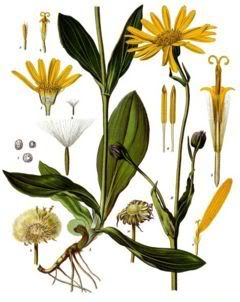What is it about really bad bruises that makes people want to show them off? Maybe it’s just me, but last month I returned to NYC with a bruise the size and near circumference of a softball on the back of my leg, and the first thing I did was to pull up my skirt and show my roommate.
“What happened?” she asked. “An unfortunate collision with the bow of a boat after hitting some particularly turbulent wake,” I said. Literally air borne for a good five seconds, I was on my way down when the boat’s lip came right up to meet me. *Smack* Right then I knew it was going to be bad. A two-monther, for sure. Maybe three.
Always resourceful and with a closet full of interesting ointments and balms, my roommate tossed me a tube. “I don’t know if this will work, but you could give it a try,” she said. And so I did.
For the next two weeks I applied
Boiron’s Arnica Gel (2.6 oz, $9.94) to my bruise twice daily. And to my (and her) complete surprise, it worked—before the end of the month the bruise was completely gone. (Hand on heart, I swear!)
Arnica gel
(Arnica Montana), a.k.a. mountain tobacco a.k.a. leopard’s bane, is a homeopathic remedy that has been used for medicinal purposes by both the Europeans and Native Americans since the 1500s. Whether applied topically—as a cream, ointment, gel, salve or tincture to treat sprains, bruises, wounds, muscle aches, insect bites, and even the swelling of the veins under the skin—or taken internally—to aid in the healing of internal trauma and even as a cure for jet lag—this wonder plant has been hailed as a continental cure all for some time now outside of the US.
And I’m totally behind it. From day one strange and miraculous things began to occur. A few hours after I applied the first heavy coat, I realized that I was no longer noticing my stiff and aching bruise. Up until then, then being maybe two days since the bump, I was very much aware of it anytime I moved or flexed the affected leg. A day and a half later, even more things started to occur worth noticing—the color, for one, and the size for another. The rim around my bruise turned dark purple, indigo really, while the inside started turning shades of first lavender and then pink. Following this, I began to notice that the meaty part of the bruise, i.e. where direct impact occurred, was beginning to first firm up and then shrink. Nearly twelve days into the treatment, all that was left was a faint nude shading, circular in shape and where my once nasty bruise was. Now, three weeks after the fact, there is literally no evidence at all to behold. A miracle that my friends and I observed with much amusement.
So how did this all work? Well, apparently this little yellow flower has anti-inflammatory properties, also acting to stimulate blood flow—thus helping to reduce discoloration of the skin, along with the stiffness and soreness associated with bruising. A bruise, after all, is nothing more that a cluster of inflamed damaged capillaries, so you can see where arnica’s attributes come in handy.
Even though there are some nay-sayers out there (“At homeopathic doses, this herbal remedy did not prevent the black and blues” says George J. Hruza, M.D., in
Journal Watch Dermatology March 28, 2006), there have been many more to the contrary. For proof, here’s one: Research from the Archives of Facial and Plastic Surgery shows that when arnica is taken orally before surgery it reduces inflammation and reduces bruising. Most revealing, I think, are the use of treatments out there that use arnica gel as a component in their product. For example, according to a March 5, 2008 article in London’s
Evening Standard,
“Surgeons create ‘miracle’ skin-healing gel,” one of the ten super-ingredients used to sooth, repair and minimize scarring, includes arnica.
Note that homeopathic doses are very small and safe. In large doses, arnica should not be taken orally and there is evidence that using it for a long time may irritate the skin, causing eczema, peeling, blisters, or other skin conditions. Arnica should not be used on broken skin (
source)
Truth be told, when it comes to homeopathic remedies, there will always be some voices of dissent and skepticism; but accompanying them are throngs of others, testifying of its benefits, and going back throughout the ages. As for me, I’ve found a new medicine cabinet staple.





June 13, 2009
by marta
Unfortunately, I don't think that arnica works on scar tissue. You could try Bio-Oil - read Stephanie's post <a href="http://www.truthinaging.com/2009/06/reader-reviewed-and-recommended-bio-oil.html" rel="nofollow">here</a>
June 13, 2009
by Michelle
Hi Claire,
Do you know if this, or any other product works on scars or insect bites that leave a discoloration or slightly darker pigment in the skin? Like those small brownish dots or marks on the ankles or wrists or legs due to things like fading scars, bites, bruises, scratching, or recovering popped blisters? Thank you. They're nothing too major, but small things add up, and it's annoying to have little spots and dots everywhere. Looks like fading eczema or something.